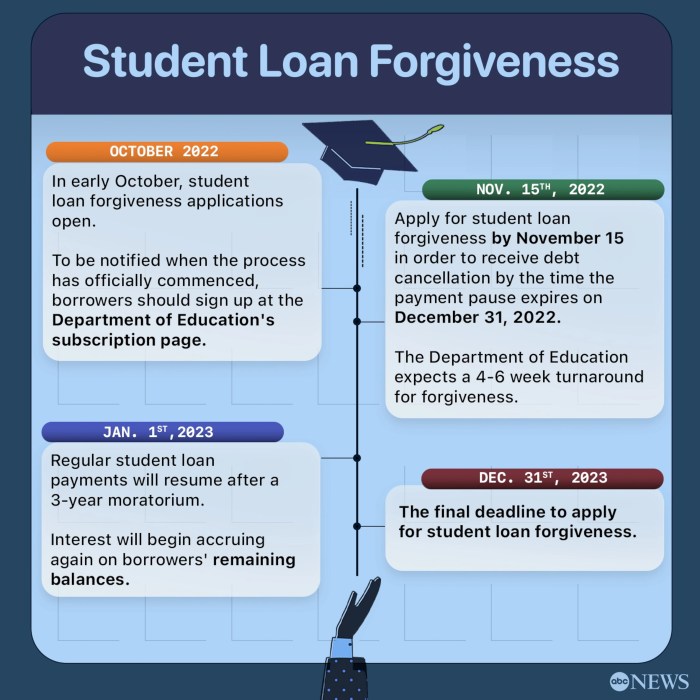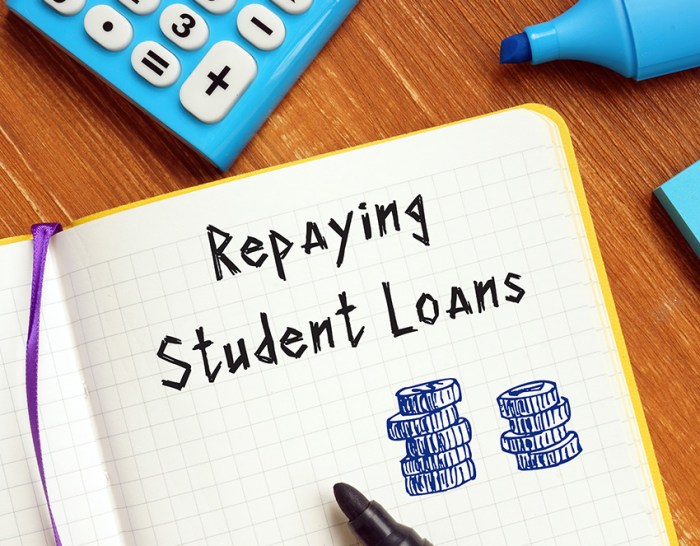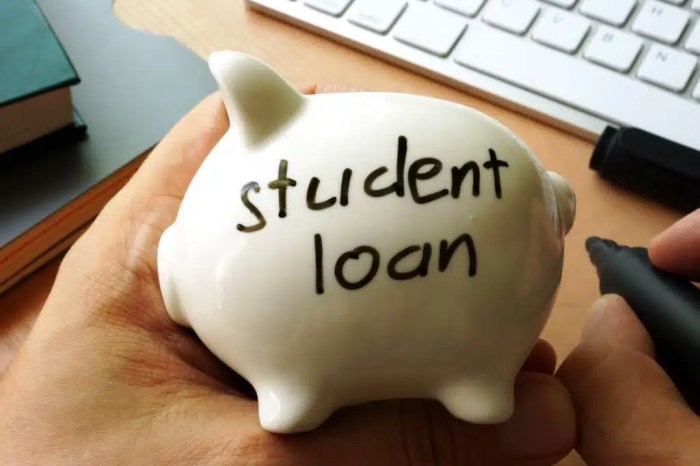
Successfully navigating the complexities of student loan repayment and achieving complete debt freedom is a significant financial milestone. This guide provides a comprehensive roadmap, covering everything from understanding your loan details to developing a robust repayment strategy and securing the necessary funds. We’ll explore various repayment options, budgeting techniques, and post-repayment planning to empower you to achieve financial independence.
From identifying different loan types and calculating your total debt to exploring lump-sum payments and refinancing possibilities, we’ll equip you with the knowledge and tools needed to make informed decisions. We’ll also delve into strategies for maintaining sound financial health post-repayment, ensuring your hard work translates into long-term financial security.
Understanding Your Student Loan Debt
Paying off your student loans in full requires a clear understanding of your debt. This involves identifying the types of loans you have, accessing your loan details, and calculating your total repayment amount. Failing to understand these aspects can lead to missed payments and increased interest charges.
Federal and Private Student Loans
Student loans are broadly categorized into federal and private loans. Federal loans are offered by the U.S. government and typically have more borrower protections, such as income-driven repayment plans and loan forgiveness programs. Private loans, on the other hand, are provided by banks, credit unions, and other private lenders. These loans often have higher interest rates and fewer protections than federal loans. Specific loan types within these categories include subsidized and unsubsidized federal Stafford loans, Grad PLUS loans, and Parent PLUS loans (all federal), and various types of private loans (e.g., variable-rate, fixed-rate, etc.). Understanding which type of loan you have is crucial in determining your repayment strategy.
Accessing Loan Details and Statements
To manage your student loans effectively, you need access to your loan details and statements. For federal loans, you can access your information through the National Student Loan Data System (NSLDS). This website provides a comprehensive overview of your federal student loans, including loan balances, interest rates, and repayment schedules. For private loans, you will need to contact your lender directly to obtain your loan statements and account information. Most lenders provide online access to account details, allowing you to monitor your balance and payment history. Regularly reviewing your statements is essential to ensure accuracy and identify any potential issues.
Calculating Total Amount Owed
Calculating the total amount owed on your student loans requires careful consideration of the principal balance and accrued interest. The principal balance is the original amount you borrowed. Interest is the cost of borrowing money, and it accrues over time. The formula for calculating simple interest is: Interest = Principal x Rate x Time. However, most student loans use compound interest, where interest is calculated on both the principal and accumulated interest. To accurately calculate your total amount owed, including accrued interest, you can use an online student loan calculator or contact your lender for an amortization schedule. This schedule provides a detailed breakdown of your loan payments, showing how much of each payment goes towards principal and interest.
Comparison of Loan Types
The following table compares the interest rates and repayment terms of various loan types. Note that interest rates and repayment terms can vary depending on the lender and your individual circumstances. These are examples and may not reflect current rates.
| Loan Type | Interest Rate (Example) | Repayment Period (Example) | Total Cost (Example) |
|---|---|---|---|
| Federal Subsidized Stafford Loan | 3.73% | 10 years | $12,000 (for a $10,000 loan) |
| Federal Unsubsidized Stafford Loan | 5.28% | 10 years | $13,000 (for a $10,000 loan) |
| Private Loan (Fixed Rate) | 7% | 5 years | $11,500 (for a $10,000 loan) |
| Private Loan (Variable Rate) | 6-9% (variable) | 7 years | $12,500 – $15,000 (for a $10,000 loan) |
Exploring Repayment Options

Paying off your student loans in full requires careful consideration of your repayment strategy. Choosing the right approach can significantly impact your financial well-being and the total amount you end up paying. This section will explore different repayment options, highlighting their advantages and disadvantages to help you make an informed decision.
Lump-Sum Repayment versus Structured Repayment Plans
A lump-sum repayment involves paying off your entire loan balance at once. Structured repayment plans, on the other hand, involve making regular payments over a set period. Both approaches have their own merits and drawbacks.
| Repayment Method | Pros | Cons |
|---|---|---|
| Lump-Sum Repayment |
|
|
| Structured Repayment Plans |
|
|
Implications of Early Repayment on Interest Savings
Early repayment of student loans significantly reduces the total interest paid. Interest is typically calculated on the outstanding loan balance, so paying down the principal early lowers the base upon which interest accrues. The savings can be substantial, especially with high-interest loans. For example, consider a $30,000 loan with a 6% interest rate over 10 years. Paying it off early, even by a year or two, can save thousands of dollars in interest. The exact savings depend on the loan’s interest rate, principal balance, and repayment schedule.
Examples of Different Repayment Plans
Several repayment plans cater to different financial situations. These include standard, graduated, and income-driven repayment plans.
| Repayment Plan | Description | Pros | Cons |
|---|---|---|---|
| Standard Repayment Plan | Fixed monthly payments over a standard 10-year period. |
|
|
| Graduated Repayment Plan | Payments start low and gradually increase over time. |
|
|
| Income-Driven Repayment Plan | Monthly payments are based on your income and family size. |
|
|
Finding the Funds for Full Payment

Paying off your student loans in full can feel daunting, but with careful planning and resourcefulness, it’s achievable. This section Artikels various strategies for accumulating the necessary funds and developing a robust repayment plan. Remember, the key is to create a realistic budget and explore all available options.
Potential Funding Sources
Several avenues exist for accumulating the funds needed to pay off student loans in full. These range from utilizing existing savings to generating additional income through various means. Careful consideration of each option’s feasibility and potential impact on your overall financial picture is crucial.
- Savings and Investments: Existing savings accounts, retirement funds (with careful consideration of potential penalties), and investment portfolios can be tapped into for loan repayment. This approach requires careful assessment of your financial security and long-term goals. For example, using a portion of a well-diversified investment portfolio may be a viable option if it won’t jeopardize future financial stability.
- Bonuses and Windfalls: Unexpected income, such as year-end bonuses, tax refunds, inheritance, or lottery winnings, can be strategically allocated towards student loan repayment to accelerate the payoff process. A realistic plan for utilizing such windfalls should be in place before they are received.
- Side Hustles and Additional Income Streams: Generating extra income through freelance work, part-time jobs, or the sale of unused assets can significantly contribute to faster loan repayment. Examples include driving for a ride-sharing service, offering tutoring services, or selling crafts online.
Budgeting Strategies for Loan Repayment
Effective budgeting is paramount in allocating funds for student loan repayment. This involves tracking expenses, identifying areas for savings, and creating a realistic repayment plan.
A detailed budget should include all income sources and expenses. Categorize expenses to identify areas where spending can be reduced. For example, reducing dining out expenses, canceling unnecessary subscriptions, or finding cheaper alternatives for transportation can free up significant funds. Once savings are identified, allocate a specific amount each month towards student loan repayment. Consider using budgeting apps or spreadsheets to track progress and maintain accountability.
Student Loan Refinancing
Refinancing your student loans can potentially lower your monthly payments and reduce the total interest paid over the life of the loan. This involves securing a new loan from a lender at a lower interest rate than your current loan(s). However, it’s important to thoroughly research different lenders and compare interest rates, fees, and terms before refinancing. It’s also crucial to understand the implications of refinancing, such as potentially extending the repayment period. Only refinance if it results in significant savings and aligns with your overall financial goals.
Securing Funds and Planning for Full Repayment: A Flowchart
The following flowchart illustrates the steps involved in securing funds and planning for full student loan repayment:
[Imagine a flowchart here. The flowchart would begin with “Assess Current Financial Situation,” branching to “Identify Funding Sources” (Savings, Investments, Bonuses, Side Hustles), then to “Create a Detailed Budget,” leading to “Allocate Funds for Loan Repayment.” A separate branch from “Identify Funding Sources” would lead to “Explore Refinancing Options,” which would then connect to “Allocate Funds for Loan Repayment.” Finally, “Allocate Funds for Loan Repayment” would lead to “Monitor Progress and Adjust as Needed.”]
This flowchart visually represents the iterative process of securing funds and managing repayment. Regular monitoring and adjustments are essential to ensure the plan remains effective and achievable.
The Repayment Process

Paying off your student loans in full can be a significant accomplishment. This section details the steps involved in making a lump-sum payment, ensuring a smooth and efficient process. Understanding the process beforehand will help alleviate any potential stress and ensure your payment is properly processed.
Making a lump-sum payment typically involves several straightforward steps. First, you’ll need to gather your necessary information, including your loan details (loan numbers, servicer contact information), and the amount you intend to pay. Then, you’ll initiate the payment through your chosen method, whether online, by mail, or via phone. Finally, you’ll confirm the payment’s receipt and keep records of the transaction for your records.
Initiating a Lump-Sum Payment
To begin, locate your student loan servicer’s contact information. This information can usually be found on your monthly statements or through the National Student Loan Data System (NSLDS). Once you have this information, you can access their online payment portal, which usually provides a secure way to make payments. Alternatively, you can mail a check or money order, ensuring it includes all necessary information (your loan number, your name, and the amount). Phone payments may also be an option, though they are less common. Always confirm the payment method’s instructions and deadlines with your servicer.
Payment Verification and Documentation
After submitting your payment, it’s crucial to verify its successful processing. Most online portals will provide immediate confirmation. For mailed payments, allow sufficient processing time (usually a few business days) before contacting your servicer. Documentation will vary; online payments usually provide an electronic confirmation. For mailed payments, keep a copy of your check or money order and the tracking information if you used a traceable method. Your servicer may also provide a confirmation statement or update your account balance online, reflecting the payment. If you encounter issues, contact your servicer directly to inquire about the status of your payment. They may request additional documentation, such as a cancelled check or bank statement.
Communication Methods and Receipt Confirmation
Several communication methods can be used to confirm payment and obtain receipts. Most servicers offer online account access, allowing you to check your account balance and view transaction history. Email is another common communication channel for confirming payment details and receiving electronic receipts. Phone calls can be useful for immediate clarification, but it’s advisable to follow up with a written confirmation to document the conversation. Finally, requesting a written payment confirmation via mail can provide a physical record of your payment. Choosing the most suitable method depends on your preference and the servicer’s available options. It’s always best to obtain a written confirmation of your payment for your records.
Pre-Payment, Payment, and Post-Payment Checklist
Before initiating your full payment, ensure you’ve gathered all necessary information (loan details, payment amount, and chosen payment method). Verify your account balance and confirm the total amount due to avoid any discrepancies. During the payment process, meticulously follow your servicer’s instructions, double-checking all entered information for accuracy. After making the payment, obtain a confirmation from your servicer, keeping a copy of the confirmation for your records. Monitor your account online to confirm that the payment has been applied correctly to your loan balance. Finally, maintain all documentation related to the payment, including confirmations, receipts, and bank statements.
Post-Repayment Considerations
Paying off your student loans represents a significant financial achievement, opening doors to enhanced financial stability and future opportunities. The feeling of freedom from this debt allows for greater control over your finances and a more confident approach to long-term financial planning. This section explores the benefits of being debt-free and Artikels strategies to maintain and improve your financial health moving forward.
Benefits of Being Debt-Free
Eliminating student loan debt significantly improves your overall financial well-being. The immediate impact is a substantial increase in disposable income, allowing you to allocate funds towards other crucial financial goals. This newfound financial flexibility reduces stress and improves mental well-being, as the constant pressure of loan repayments is removed. Furthermore, a debt-free status improves your credit score, making it easier to qualify for loans, mortgages, and credit cards with favorable interest rates in the future. This enhanced creditworthiness translates to better financial opportunities and potentially significant long-term savings.
Strategies for Maintaining Good Financial Health
Maintaining good financial health after paying off student loans requires a proactive and disciplined approach. Budgeting remains crucial; however, the absence of loan payments allows for greater flexibility in allocating funds. Consider increasing contributions to retirement accounts, such as a 401(k) or IRA, to maximize tax advantages and build a secure financial future. Prioritize building an emergency fund, ideally with 3-6 months’ worth of living expenses, to safeguard against unexpected events. Regularly reviewing your budget and adjusting it as needed is essential to adapt to changing circumstances and financial goals. Finally, continuous financial education empowers you to make informed decisions and navigate the complexities of personal finance effectively.
Building an Emergency Fund and Planning for Future Financial Goals
An emergency fund acts as a safety net, protecting against unforeseen circumstances such as job loss, medical emergencies, or car repairs. A common recommendation is to save 3-6 months’ worth of living expenses. Start by setting a realistic savings goal and automate regular contributions to a dedicated savings account. Consider using high-yield savings accounts to maximize interest earnings. Once an emergency fund is established, you can focus on other financial goals, such as purchasing a home, investing in the stock market, or starting a family. Prioritizing these goals and developing a clear financial plan allows you to achieve them systematically and confidently.
Sample Post-Repayment Budget
The following is a sample post-repayment budget, illustrating how funds previously allocated to loan payments can be redirected towards savings and investment goals. This is a simplified example and should be adapted to individual circumstances.
| Category | Amount |
|---|---|
| Housing | $1,500 |
| Food | $500 |
| Transportation | $300 |
| Utilities | $200 |
| Healthcare | $100 |
| Entertainment | $200 |
| Emergency Fund | $500 |
| Retirement Savings | $500 |
| Investment (Stocks/Bonds) | $200 |
| Debt Repayment (Other) | $0 |
| Total | $3,500 |
This budget shows a significant portion of income allocated to savings and investments, reflecting the opportunities available after eliminating student loan debt. The exact allocation will depend on individual circumstances, risk tolerance, and financial goals. Remember that this is just a sample; your budget should reflect your personal financial situation and goals.
Final Review
Paying off your student loans in full is a substantial achievement requiring careful planning, diligent execution, and a commitment to financial discipline. By understanding your loan details, exploring diverse repayment strategies, and securing the necessary funds through effective budgeting and potentially refinancing, you can pave the way to financial freedom. Remember, the journey to debt-free living is a marathon, not a sprint, and the rewards of perseverance are well worth the effort. Maintain a proactive approach to your finances even after repayment, ensuring long-term financial well-being.
Clarifying Questions
What if I can’t afford a lump-sum payment?
Explore structured repayment plans offered by your loan servicer. These plans allow for smaller, more manageable monthly payments over a longer period.
Can I negotiate a lower interest rate with my lender?
While not always possible, it’s worth contacting your lender to inquire about potential interest rate reductions, especially if your credit score has improved significantly since you took out the loan.
What happens if I make an extra payment and then miss a scheduled payment?
Contact your loan servicer immediately. They can help you understand the implications and potentially work out a solution. Clear communication is key.
What are the tax implications of paying off student loans?
Generally, student loan payments are not tax-deductible. However, consult a tax professional for personalized advice based on your specific circumstances.
